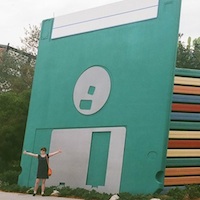Open Source Bridge 2017
23 Jun 2017This week, I went to Open Source Bridge in Portland, OR. It’s a conference “for developers working with open source technologies and for people interested in learning the open source way.” Usually I spend a lot of time taking notes for myself and others via tweeting, but this time I decided to chill on the tweets and try to wrap things up as a blog overview instead.
Day 1!
Tech Reform
Nicole Sanchez asked us to share what we thought the most important issues were using the hashtag #techreform on twitter and would be aggregating this and creating a Github repository with these broken down as Issues.
Inclusive Writing Workshop
Was unsure about this at first, as a person feeling fairly well-versed in these topics, but it was very helpful to think through these things through hands-on activities such as interviewing people and writing biographies inclusively. Thank you, Thursday!
Stenography
Josh Lifton from Crowd Supply showed us how interesting stenography is and what a great open source community has started thriving around it!
Why low tech?
“Who are we democratizing things for?”
I got a lot out of this talk because I’m interested in thinking through webpage payload size as a major barrier for low-connectivity regions, a crucial component to accessibility that doesn’t get (IMO) as much discussion. This talk gave some good examples, like YouTube’s homepage alone creating a barrier for low-speed internet regions because it was so big, people learning to code on their non-smart phones, advocacy via phonelines when the internet is intentionally shut down, and about how video needs to work in desktop/mobile in more ways than “size of display.” Glad to see these can be tested in DevTools, by throttling down to see how slow a page loads using 2G, etc. In the slides you can see a great analogy to explain web slowness in terms of “it’d take you this long to walk this distance and to load a 10mb webpage on a 250kbps connection.”
Cryptography
Niharika Kohli gave us a historical overview of ancient and semi-ancient cipher techniques. She discussed steganography, microdots, printer yellow dots, image steganography (turning a tree into a cat), Transposition cypher, Rail Fence Transposition, Route Transposition Mono-alphabetic substitution cipher, Caesar Cipher and frequency analysis, the “Unbreakable Cipher”, Jefferson Disk, Beale Ciphers, Charles Babbage, Arthur Zimmermann, and more. The best part about this was getting quizzed at the end and how badly the audience did at solving ciphers quickly and easily.
Democratizing Data
What should we ask as developers to push the needle further? Lorena Mesa was asking all of the right questions here:
- People who have access and make publications of our data, where’s the line here?
- Are the people making software purchasing decisions doing right byt the people working on the ground?
- How do we have conversations around ethics of data cultivation and usage?
- How does design in software change the social fabric around us? (E.g., Airbnb’ing while black)
- What kind of ethics training do you do for your team?
- Let’s talk about our data lifecycle – what is your organization’s policy? Storing, using, but what happens after its been a use in a while, or no longer useful?
- Are we thinking about deleting data or how to repurpose data? Are we thinking about how to give people permission to remove their data?
- If you are a startup that gets bought, what happens to that data?
She recommends:
- Start with a data model and do a data map!
- Using Swagger to surface these decisions, make them open and easy to explore for people who are non-coders, and also help with this data collection ethics issues in the future.
- Google Data Liberation Front Project
- Liz Rush - Challenging & Democratizating Algorithm Development
- An Introduction to Software Engineering Ethics
- Note to Self podcast
Day 2!
At the end of the second day, Andrew Weaver and I spoke about open source tools used by a/v archivists. Day 2 was a little heavier in the Hacker’s Lounge, reviewing our talk before giving it.
Of (biased) note is a talk from Travis Wagner about connections between open source and MLIS classrooms, wherein which he teaches at the University of South Carolina.
Day 3!
Day 3, I ditched my laptop so I don’t have notes. Some highlights:
- Tweet thread on the Oracle vs. Google session given by Sarah Jeong
- Failing Well by Jason Clark
- Debug Better: 2017 Edition. Take control of your bugs!
Thanks so much to the Open Source Bridge volunteers, fellow speakers, and conference attendees!
